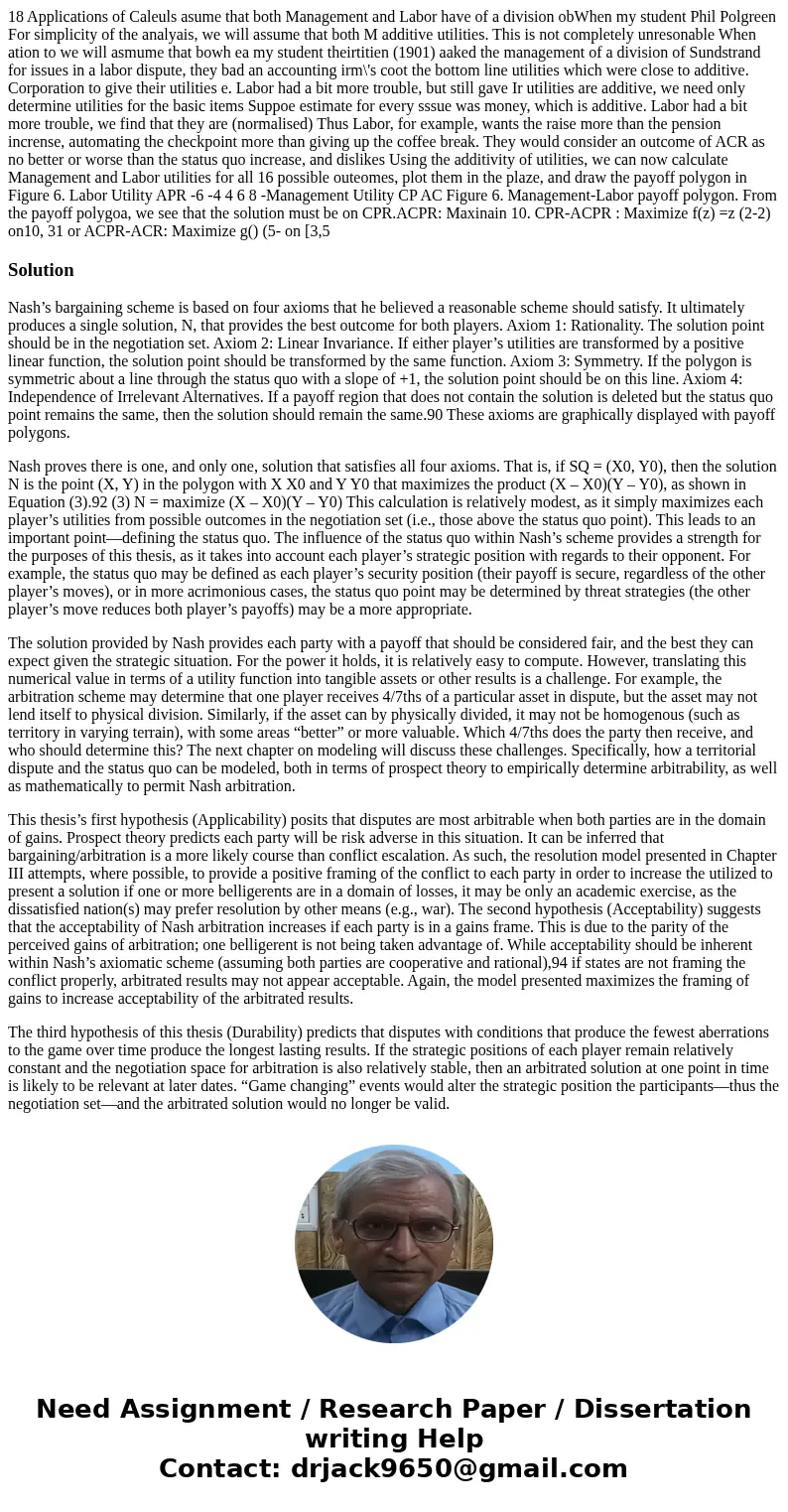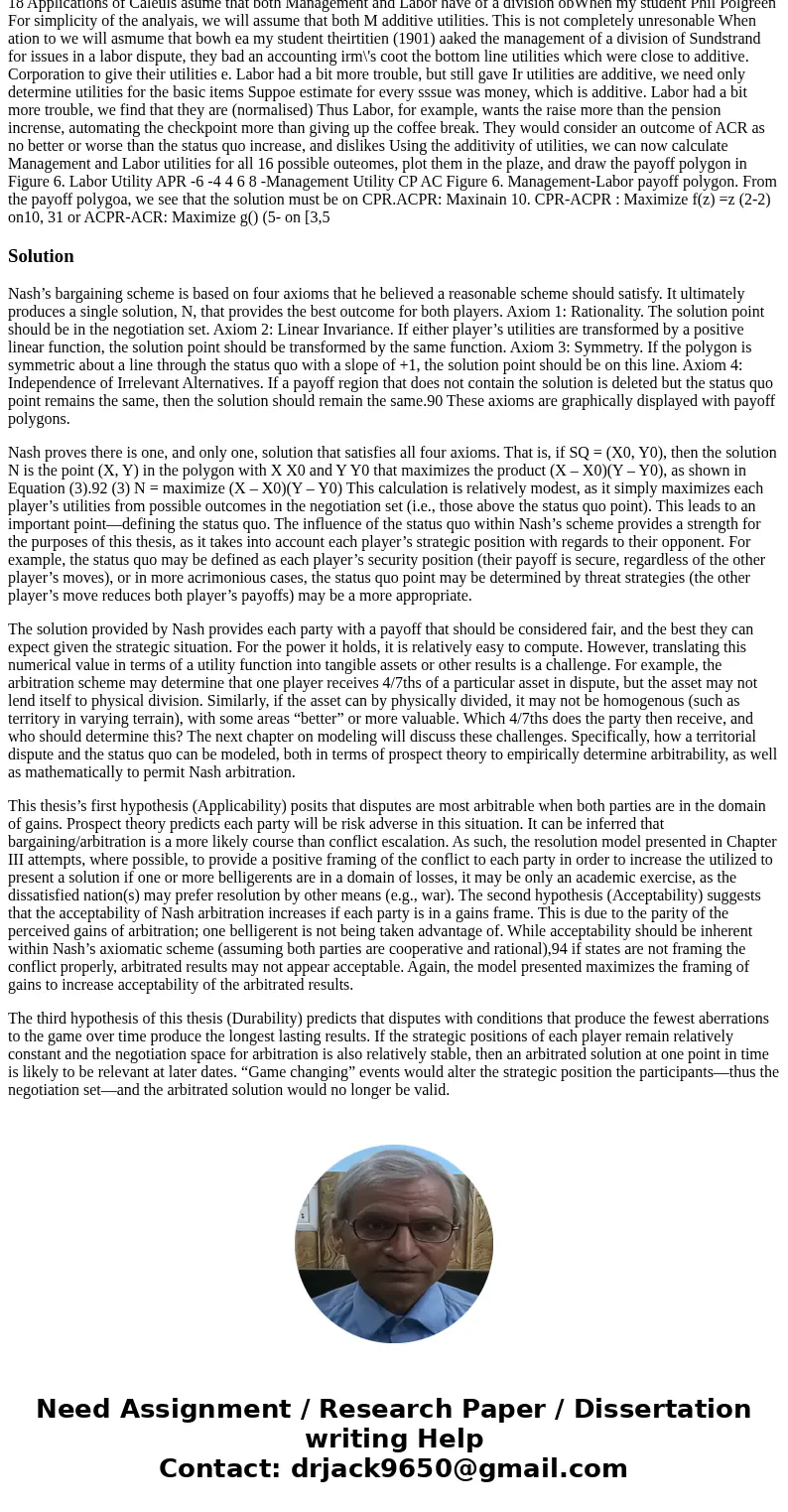18 Applications of Caleuls asume that both Management and La
Solution
Nash’s bargaining scheme is based on four axioms that he believed a reasonable scheme should satisfy. It ultimately produces a single solution, N, that provides the best outcome for both players. Axiom 1: Rationality. The solution point should be in the negotiation set. Axiom 2: Linear Invariance. If either player’s utilities are transformed by a positive linear function, the solution point should be transformed by the same function. Axiom 3: Symmetry. If the polygon is symmetric about a line through the status quo with a slope of +1, the solution point should be on this line. Axiom 4: Independence of Irrelevant Alternatives. If a payoff region that does not contain the solution is deleted but the status quo point remains the same, then the solution should remain the same.90 These axioms are graphically displayed with payoff polygons.
Nash proves there is one, and only one, solution that satisfies all four axioms. That is, if SQ = (X0, Y0), then the solution N is the point (X, Y) in the polygon with X X0 and Y Y0 that maximizes the product (X – X0)(Y – Y0), as shown in Equation (3).92 (3) N = maximize (X – X0)(Y – Y0) This calculation is relatively modest, as it simply maximizes each player’s utilities from possible outcomes in the negotiation set (i.e., those above the status quo point). This leads to an important point—defining the status quo. The influence of the status quo within Nash’s scheme provides a strength for the purposes of this thesis, as it takes into account each player’s strategic position with regards to their opponent. For example, the status quo may be defined as each player’s security position (their payoff is secure, regardless of the other player’s moves), or in more acrimonious cases, the status quo point may be determined by threat strategies (the other player’s move reduces both player’s payoffs) may be a more appropriate.
The solution provided by Nash provides each party with a payoff that should be considered fair, and the best they can expect given the strategic situation. For the power it holds, it is relatively easy to compute. However, translating this numerical value in terms of a utility function into tangible assets or other results is a challenge. For example, the arbitration scheme may determine that one player receives 4/7ths of a particular asset in dispute, but the asset may not lend itself to physical division. Similarly, if the asset can by physically divided, it may not be homogenous (such as territory in varying terrain), with some areas “better” or more valuable. Which 4/7ths does the party then receive, and who should determine this? The next chapter on modeling will discuss these challenges. Specifically, how a territorial dispute and the status quo can be modeled, both in terms of prospect theory to empirically determine arbitrability, as well as mathematically to permit Nash arbitration.
This thesis’s first hypothesis (Applicability) posits that disputes are most arbitrable when both parties are in the domain of gains. Prospect theory predicts each party will be risk adverse in this situation. It can be inferred that bargaining/arbitration is a more likely course than conflict escalation. As such, the resolution model presented in Chapter III attempts, where possible, to provide a positive framing of the conflict to each party in order to increase the utilized to present a solution if one or more belligerents are in a domain of losses, it may be only an academic exercise, as the dissatisfied nation(s) may prefer resolution by other means (e.g., war). The second hypothesis (Acceptability) suggests that the acceptability of Nash arbitration increases if each party is in a gains frame. This is due to the parity of the perceived gains of arbitration; one belligerent is not being taken advantage of. While acceptability should be inherent within Nash’s axiomatic scheme (assuming both parties are cooperative and rational),94 if states are not framing the conflict properly, arbitrated results may not appear acceptable. Again, the model presented maximizes the framing of gains to increase acceptability of the arbitrated results.
The third hypothesis of this thesis (Durability) predicts that disputes with conditions that produce the fewest aberrations to the game over time produce the longest lasting results. If the strategic positions of each player remain relatively constant and the negotiation space for arbitration is also relatively stable, then an arbitrated solution at one point in time is likely to be relevant at later dates. “Game changing” events would alter the strategic position the participants—thus the negotiation set—and the arbitrated solution would no longer be valid.


 Homework Sourse
Homework Sourse